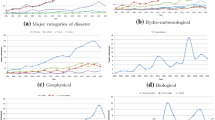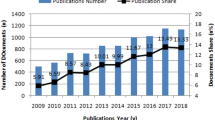Abstract
Disasters are cataclysmic events that cause significant loss of natural, human and financial resources. The repercussions are exaggerated by climate change making disaster management a hot topic for academic research. The exponential growth in the utilization of ICT (Information and Communication Technology) with other domains has motivated the scientific community to integrate it with disaster management. The aim of this paper is to put forward a scientometric examination to assess the corpus of research performed on various types of disasters and use of ICT over the last 10 years. Annual growth of publication output, related subject categories, productivity analysis parameters were calculated for the evaluation of scopus bibliographic data. Moreover, it presents insights into productive journals, co-operation of qualified authors and collaboration of nations from all over the world. It further investigates prominent institutes and co-occurrence of key research topics. This organized study will facilitate the upcoming authors for effective future research.













Similar content being viewed by others
References
Anderson EW (1994) Disaster management and military. GeoJournal 34(2):201–205
Asokan A, Anitha J (2019) Change detection techniques for remote sensing applications: a survey. Earth Science Informatics
Bhattacharjee S, Roy S, DasBita S (2018) DPDRM: A decentralized post-disaster resource management scheme using energy efficient smart phone based DTN. J Netw Comput Appl 111:1–16
Boulos M N K, et al. (2011) Crowdsourcing, citizen sensing and sensor web technologies for public and environmental health surveillance and crisis management: trends, OGC standards and application examples. Int J Health Geogr 10(1):67
Castillo-Vergara M, Alvarez-Marin A, Placencio-Hidalgo D (2018) A bibliometric analysis of creativity in the field of business economics. J Bus Res 85:1–9
Cobo M J, et al. (2011) Science mapping software tools: Review, analysis, and cooperative study among tools. Journal of the American Society For Information Science And Technology 62(7):1382–1402
Corominas J, et al. (2014) Recommendations for the quantitative analysis of landslide risk. Bull Eng Geol Environ 73(2):209–263
Dale M et al (2014) Probabilistic flood forecasting and decision-making: an innovative risk-based approach. Natural Hazards 70.
Devasena A, Sowmya B (2015) Wireless sensor network in disaster management. Indian Journal of Science and Technology 8(15)
Eck N JV, Waltman L (2010) Software survey: VOSviewer, a computer program for bibliometric mapping. Scientometrics 84:523–538
Elsevier (2017) A Global Outlook on Disaster Science. https://www.elsevier.com/_data/assets/pdf_file/0008/538091/ElsevierDisasterScienceReport-PDF.pdf. Last accessed on 10 July, 2019
Groger G, Plumer L (2012) CityGML – Interoperable semantic 3D city models. ISPRS J Photogramm Remote Sens 71:12–33
Guha-Sapir D, Hoyois P, Below R (2016) Annual Disaster Statistical Review 2015: the numbers and trends. The Centre for Research on the Epidemiology of Disasters
Harzing A, Alakangas S (2016) Google scholar, scopus and the Web of science: a longitudinal and cross-disciplinary comparison. Scientometrics 106(2):787–804
Hirsch J E (2005) An index to quantify an individual’s scientific research output. Proc Natl Acad Sci USA 102(46):16569–16572
International Atomic Energy Agency (2015) The Fukushima Daiichi Accident. https://www-pub.iaea.org/MTCD/Publications/PDF/Pub1710-ReportByTheDG-Web.pdf. Last accessed on 10 July, 2019
International Federation of Red Cross and Red Crescent Societies (IFRC) (2016) World Disasters Report Resilience: saving lives today, investing for tomorrow. https://www.ifrc.org/Global/Documents/Secretariat/201610/WDR%202016-FINAL_web.pdf. Last accessed on 11 July, 2019
Jacso P (2006) Deflated, inflated and phantom citation counts. Online Inf Rev 30(3):297–309
Jadhav S. S., Kulkarni AV, Menon R (2014) Mobile Ad-Hoc Network (MANET) for disaster management. 2014 11th international conference on wireless and optical communications networks (WOCN). IEEE
Japan Meteorological Agency (2019) Earthquakes and tsunamis: Observation and disaster mitigation. https://www.jma.go.jp/jma/kishou/books/jishintsunami/en/jishintsunami_en.pdf. Last accessed on 13 July, 2019
Karpatne A, Ebert-Uphoff I, Ravela S, Babaie H A, Kumar V (2019) Machine learning for the geosciences: Challenges and opportunities. IEEE Trans Knowl Data Eng 31(8):1544–1554
Karle N, Oppenheimer C (2002) Satellite remote sensing as a tool in lahar disaster management. Disasters 26(2):140–160
Kumar RS, Kaliyaperuma K. (2015) A scientometric analysis of mobile technology publications. Scientometrics 105(2):921–939
Li T, et al. (2017) Data-driven techniques in disaster information management. ACM Computing Surveys 50(1)
Manavalan R (2017) SAR image analysis techniques for flood area mapping - literature survey. Earth Science Informatics 10(1)
Manno G, Smari W W, Taccari G (2015) A semantic-based federated cloud system for emergency response. Concurrency Computation Practice and Experience 27(13):3316–3344
Meho L I, Rogers Y (2008) Citation counting, citation ranking, and h-index of human-computer interaction researchers: A comparison of Scopus and Web of Science. J Am Soc Inf Sci Technol 59(11):1711–1726
Merigo J M, Pedrycz W, Weber R, de la Sotta C (2018) Fifty years of information sciences: A bibliometric overview. Inform Sci 432:245–268
Mimura N, et al. (2011) Damage from the great East Japan earthquake and tsunami - A quick report. Mitig Adapt Strat Glob Chang 16:803–818
Ministry of Home Affairs Government of India (2011) Disaster management in India. https://www.undp.org/content/dam/india/docs/disaster_management_in_india.pdf. Last accessed on 10 July, 2019
National Disaster Management Authority Government of India (2008) Management of cyclones. https://ndma.gov.in/images/guidelines/cyclones.pdf. Last accessed on 11 July, 2019
National Disaster Management Authority Government of India (2016) National disaster management plan (NDMP). https://ndma.gov.in/images/policyplan/dmplan/National%20Disaster%20Management%20Plan%20May%202016.pdf. Last accessed on 11 July, 2019
Perianes-Rodriguez A, Waltman L, Eck N J V (2016) Constructing bibliometric networks: A comparison betweenfull and fractional counting. J Informetrics 10:1178–1195
Poblet M, García-Cuesta E, Casanovas P. (2018) Crowdsourcing roles, methods and tools for data-intensive disaster management. Inf Syst Front 20(6):1363–1379
Rahman M U, et al. (2016) Implementation of ICT and wireless sensor networks for earthquake alert and disaster management in earthquake prone areas. Prog Comput Sci 85:92–99
Rawls C G, Turnquist M A (2010) Prepositioning supplies in preparation for disasters. Transp Res B Methodol 44(4):521–534
Serenko A, Bontis N (2004) Meta-review of knowledge management and intellectual capital literature, citation impact and research productivity rankings. Knowl Process Manag 11(3):185–198
Schreiber M (2013) How relevant is the predictive power of the h-index? A case study of the time-dependent Hirsch index. Journal of Informetrics
Sood S K, Sandhu R, Singla K, Chang V (2018) IoT, big data and HPC based smart flood management framework. Sustainable Computing: Informatics and Systems 20:102–117
Sweileh W M, Sa’ed HZ, Al-Jabi S W, Sawalha A F (2014) Assessing urology and nephrology research activity in Arab countries using ISI web of science bibliometric database. BMC Res Notes 7(1):258
Tralli DM et al (2005) Satellite remote sensing of earthquake, volcano, flood, landslide and coastal inundation hazards. ISPRS J Photogramm Remote Sens 59:185–198
Trapp J (2016) Web of science, scopus, and google scholar citation rates: a case study of medical physics and biomedical engineering: what gets cited and what doesn’t?. Australas Phys Eng Sci Med 39(4):817–823
United Nations Asian and Pacific Training Centre for Information and Communication Technology for Development (UN-APCICT/ESCAP) (2011) ICT for Disaster Risk Management
United Nations Office for Disaster Risk Reduction (UNISDR) (2016) Poverty & Death: Disaster Mortality 1996-2015. https://www.unisdr.org/files/50589_creddisastermortalityallfinalpdf.pdf. Last accessed on 11 July, 2019
Zhang W, Yuan H (2019) A bibliometric analysis of energy performance contracting research from 2008 to 2018. Sustainability 11(13):1–23
Zhao R, Wang J (2011) Visualizing the research on pervasive and ubiquitous computing. Scientometrics 86 (3):593–612
Author information
Authors and Affiliations
Corresponding author
Additional information
Communicated by: H. Babaie
Publisher’s note
Springer Nature remains neutral with regard to jurisdictional claims in published maps and institutional affiliations.
Rights and permissions
About this article
Cite this article
Kaur, A., Sood, S.K. Ten years of disaster management and use of ICT: a scientometric analysis. Earth Sci Inform 13, 1–27 (2020). https://doi.org/10.1007/s12145-019-00408-w
Received:
Accepted:
Published:
Issue Date:
DOI: https://doi.org/10.1007/s12145-019-00408-w




